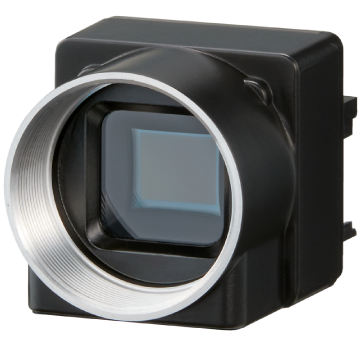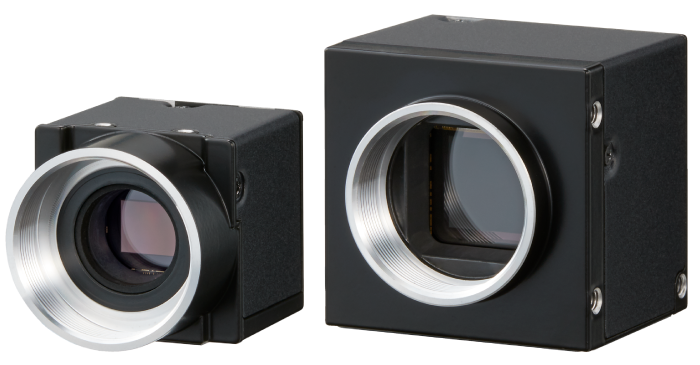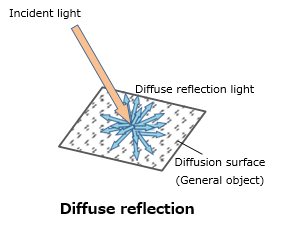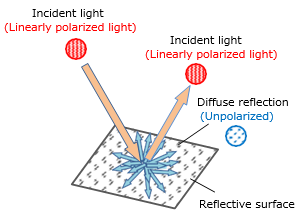Technology
Reflection & polarization of light in machine vision
Applicable products
-
CoaXPress 2.0 Camera

-
USB3 Camera

-
GigE Camera

-
Camera Link Camera

Introduction
In shooting a subject with high reflectance, “glare” or “shine” reflected by light from the source frequently affects image processing. In this case, polarizer is generally used as a countermeasure. Why only affection of glare or shine is removed? Reflection and polarization of light is described here for easy understanding.
1. Reflection of light
In order to take images with the camera, the light from the subject must be imaged on the image sensor. In case of reflective light, light from the light source is reflected by the subject. As a result. Light from the subject, as the secondary light source, is condensed and imaged through the lens. Here I would like to check the reflection of the subject.
Reflection of the subject is checked hereinafter.
1.1. Regular reflection (specular reflection) and irregular reflection (diffuse reflection)
The light from the source to the subject is reflected on the surface of the subject. At this time, when the light coming from one direction is reflected to go in the other direction. The state where the incident angle and the reflection angle of the light are same against the reflecting surface according to the “law of reflection”. It is called “regular reflection” or “specular reflection”. On the other hand, the reflection of incident light in various directions is called “irregular reflection” or “diffuse reflection” 1. A well-polished surface such as a mirror gives almost perfect specular reflection, but if the surface is not flat or rough, it will have diffuse reflection.


As for visual and camera images, the reflected light is perceived as the light source itself in case of specular reflection, while the reflected light hardly tells light source because it is reflected at various angles in diffuse reflection. As most of visible objects diffusely reflect a part of the illumination light, they look same even the view position shifts.
“Glare”, “shine” and “gloss” on the surface of an object are perceived when the ratio of specular reflection to diffuse reflection is large.
1.2. Color of reflected light
Generally, the “color” of a subject is caused by the “diffuse reflected light” from the color material layer of the object, and the “gloss” is caused by “regular reflection light” from the surface of the subject. Therefore, the reflection of the light source due to regular reflection does not reflect the color of the subject (spectral reflection characteristics), and the color of the light source is captured as it is. When the light source color is white, the color of “gloss”, “glare” or “shine” is white.
2. Polarization
2.1. Polarization state & Polarizer
“Polarization” is the light which has an electromagnetic wave only in a specific direction. It is called “non-polarized light” or “natural light” in case that there is no regularity in polarized light. Ordinary light is a mixture of light oscillating in all directions, and is in the intermediate state between polarized and unpolarized light (partially polarized light).
Polarization states include “linearly polarized light” in which the vibration direction of the electric field is constant, “circularly polarized light” in which the vibration direction changes due to light propagation, and “elliptical polarization”.
“Polarizing plate” is an optical filter that allows only light which is polarized in a specific direction to pass, and it is also capable to select only polarized light in a specific direction among unpolarized light.
2.2. Polarization states of specular reflection light and diffuse reflection light
When light is specularly reflected, the polarization is maintained in reflected light. Therefore if the incident light is linearly polarized, the reflected light will also be linearly polarized. When light is diffusely reflected, the incident light is reflected in various directions or absorbed and re-emitted by the object. Therefore even if the incident light is linearly polarized, the reflected light is unpolarized.

3. Effect of polarizing plate on reflection of light source
3.1. Arrangement and effect of polarizing plate
By taking advantage of the polarization characteristics and placing a polarizing plate in the optical system, harmful “glare” or “shine” caused by the reflection of the light source can be removed or reduced. In this case, the polarizing plate is placed on each of the light source and the lens with the polarization axis orthogonal to 90° 2. This optical arrangement eliminates the reflection of the light source on the subject caused by specularly reflected light (linearly polarized light), and allows only the diffusely reflected light (non-polarized light) to enable the camera for good shooting.



